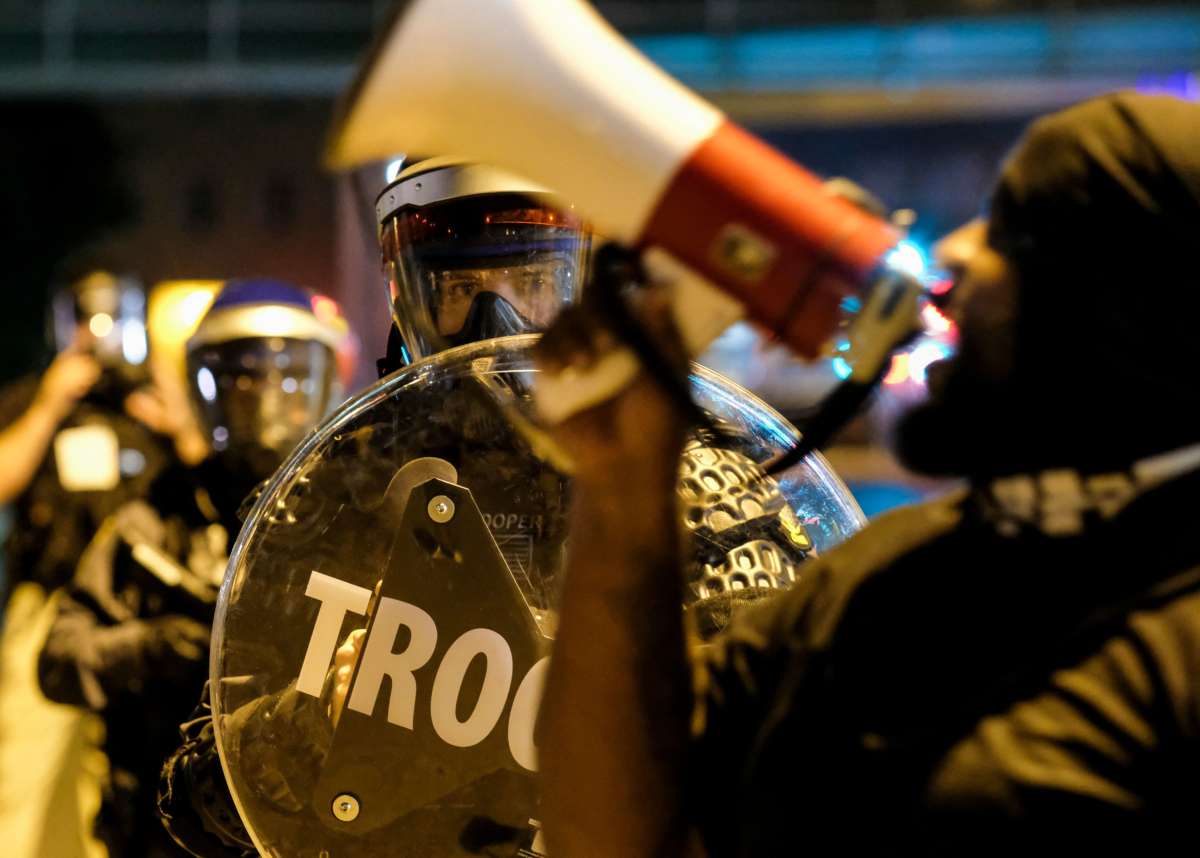Hundreds of people in Akron, Ohio gathered outside the police department’s headquarters and marched through the city late Sunday, demanding justice for Jayland Walker after police footage was released showing that the 25-year-old Black man had been fatally shot from behind at least 60 times by officers as he tried to flee from a traffic stop on June 27.
Demonstrators chanted Walker’s name and “No justice, no peace!” outside the police department and the Harold K. Stubbs Justice Center, where they were confronted by officers in riot gear as the protest continued into the evening.
Scene outside of Buchtel High. Davontae Winchester, on top of the van. “We are here for the Walker family.” pic.twitter.com/3m8MnUrvWE
— Molly Walsh (@MollyWaIsh) July 3, 2022
According to local news outlet WKYC, police officers deployed a dozen canisters of tear gas on the protesters after some knocked down barriers that were outside the police headquarters.
The response shook Rev. R. Stacey Jenkins, a pastor at the House of Prayer for All People, who joined the protests and told the Akron Beacon Journal that the bodycam footage showed no evidence of the police trying to peacefully deescalate the confrontation with Walker.
“Nothing can bring him back, but we can honor his life by seeing some quality change in how we police,” Jenkins told the newspaper.
The police department appeared to double down on defending the officers’ actions by responding to the community’s outcry with force, Jenkins suggested.
“I would respect them better if they would say, ‘We made a mistake,'” he said. “If they would say, ‘Maybe we shouldn’t have used so much force.'”
Olayemi Olurin, a public defender for Legal Aid in New York, called the “militarized” police response to the protests “insane, terrifying, and outrageous.”
I cannot find the words to really encapsulate how insane, terrifying, and outrageous it is that police could shoot someone 60 times, SIXTY TIMES, over a traffic stop, then the government response is to send out militarized police to beat and arrest anyone who says it was wrong https://t.co/xkUWKTXqX7
— Olayemi Olurin (@msolurin) July 4, 2022
Walker’s killing sparked protests and demands for the release of bodycam footage last week, as the community learned that he’d been killed after officers chased Walker during an “investigation of an unspecified traffic violation,” as the Washington Post reported.
Police claim Walker had fired a gun from his car, but his family disputes the claim and Walker was reportedly unarmed when he left his vehicle and was chased on foot by the officers.
“The police can do whatever they want,” a woman attending the protest told WKYC. “They can take our children’s lives and think it’s okay.”
Eight officers were involved in the chase which ended with the police firing about 90 rounds and shooting Walker roughly 60 times, according to an autopsy report.
“He was outgunned, outmanned,” Judi Hill, president of the Akron NAACP, told the Beacon Journal. “There’s just no reason for any of this.”
Activist Fela Sutton noted that recruiters for the Akron police department had recently attended a Juneteenth event with Black community members, giving hope to residents about amicable relations between law enforcement and the Akron community.
“You can’t build community relations doing things like [Walker’s killing],” Sutton told the Beacon Journal. “There is no reason to shoot somebody 60 times.”
We’re not backing down in the face of Trump’s threats.
As Donald Trump is inaugurated a second time, independent media organizations are faced with urgent mandates: Tell the truth more loudly than ever before. Do that work even as our standard modes of distribution (such as social media platforms) are being manipulated and curtailed by forces of fascist repression and ruthless capitalism. Do that work even as journalism and journalists face targeted attacks, including from the government itself. And do that work in community, never forgetting that we’re not shouting into a faceless void – we’re reaching out to real people amid a life-threatening political climate.
Our task is formidable, and it requires us to ground ourselves in our principles, remind ourselves of our utility, dig in and commit.
As a dizzying number of corporate news organizations – either through need or greed – rush to implement new ways to further monetize their content, and others acquiesce to Trump’s wishes, now is a time for movement media-makers to double down on community-first models.
At Truthout, we are reaffirming our commitments on this front: We won’t run ads or have a paywall because we believe that everyone should have access to information, and that access should exist without barriers and free of distractions from craven corporate interests. We recognize the implications for democracy when information-seekers click a link only to find the article trapped behind a paywall or buried on a page with dozens of invasive ads. The laws of capitalism dictate an unending increase in monetization, and much of the media simply follows those laws. Truthout and many of our peers are dedicating ourselves to following other paths – a commitment which feels vital in a moment when corporations are evermore overtly embedded in government.
Over 80 percent of Truthout‘s funding comes from small individual donations from our community of readers, and the remaining 20 percent comes from a handful of social justice-oriented foundations. Over a third of our total budget is supported by recurring monthly donors, many of whom give because they want to help us keep Truthout barrier-free for everyone.
You can help by giving today. Whether you can make a small monthly donation or a larger gift, Truthout only works with your support.
